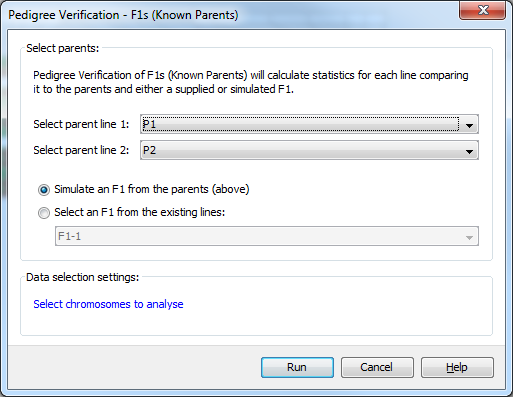Pedigree Verification Lines (parental contribution)¶
Tip
You can run this analysis as a Batch Analysis across multiple data sets (or views) at once.
This analysis provides several key statistics to determine whether a sampled line is a progeny of the expected, or designated, parents.
In addition to this help page, you can also read the Pedigree Verification - Lines (parental contribution) Tutorial, which runs through the process of running the analysis and viewing the results with a sample dataset.
Using the Pedigree Verification - Lines (parental contribution) dialog you can select the two parental lines that you are comparing sampled lines against.
The following statistics are provided;
Data count- the number of markers with non-missing values.% Data- the number of markers with non-missing values as a percent of the total markers for a sample.Het count- the number of markers with heteozygous genotypes (i.e. alleles that differ) for a sample.% Het- the number of markers with heteozygous genotypes as a percent of the total markers for a sample.% Allele Match to P1- alleles matching between the sampled line and the parent line, as a percentage of non-missing data in both the sampled line and P1, across all markers for a sample. e.g. Sampled line = A/T, C/C and P1 = A/T, C/T is a 75% match.% Allele Match to P2- alleles matching between the sampled line and the parent line, as a percentage of non-missing data in both the sampled line and P2, across all markers for a sample. e.g. Sampled line = A/A, C/T and P2 = A/T, C/T is a 75% match.% Allele Derived P1- alleles in the sampled line that could be derived (or inherited from) from the parent line, as a percentage of non-missing data in both the sampled line and P1, across all markers for a sample. e.g. Sampled line = A/T, C/C and P1 = A/T, C/T is a 100% match. Note the difference compared with % Allele Match; a sample C/C is a 50% match to parent C/T, but could be 100% derived from the parent, as both C alleles could have been inherted from parent C/T% Allele Derived P2- alleles in the sampled line that could be derived (or inherited from) from the parent line, as a percentage of non-missing data in both the sampled line and P2, across all markers for a sample. e.g. Sampled line = A/A, C/T and P2 = A/T, C/T is a 100% match.Note the difference compared with % Allele Match; a sample with A/A is a 50% match to parent A/T, but could be 100% derived from the parent, as both A alleles could have been inherted from parent A/T% Allele Match to P1 / P2- alleles in the sampled line that match an allele in EITHER P1 OR P2, as a percentage of non-missing data in both the sampled line and either parent, across all markers for a sample. e.g. Sampled line = A/T C/C, P1 = T/T C/G and P2 = T/T C/C is a 75% match.
These statistics can be used to filter results;
Data Count and % Data- since for many pedigree tests a small number of markers are used, the results can first be filtered byData Countor% Datato eliminate potentially skewed results.% Het- % het data can be used to assess whether the expected generation has been sampled eg if sampling is on fixed lines, and a sampled line has unexpectedly high hets, this line could be filtered out from being selected.% Allele Match to P1 / P2- this is the key test for whether a sampled line is derived from the expected parents. If there is a low match, then the other tests can be used to determine whether the sampled line is a self, or seed mix-up, or is derived from one parent, but not the other.
